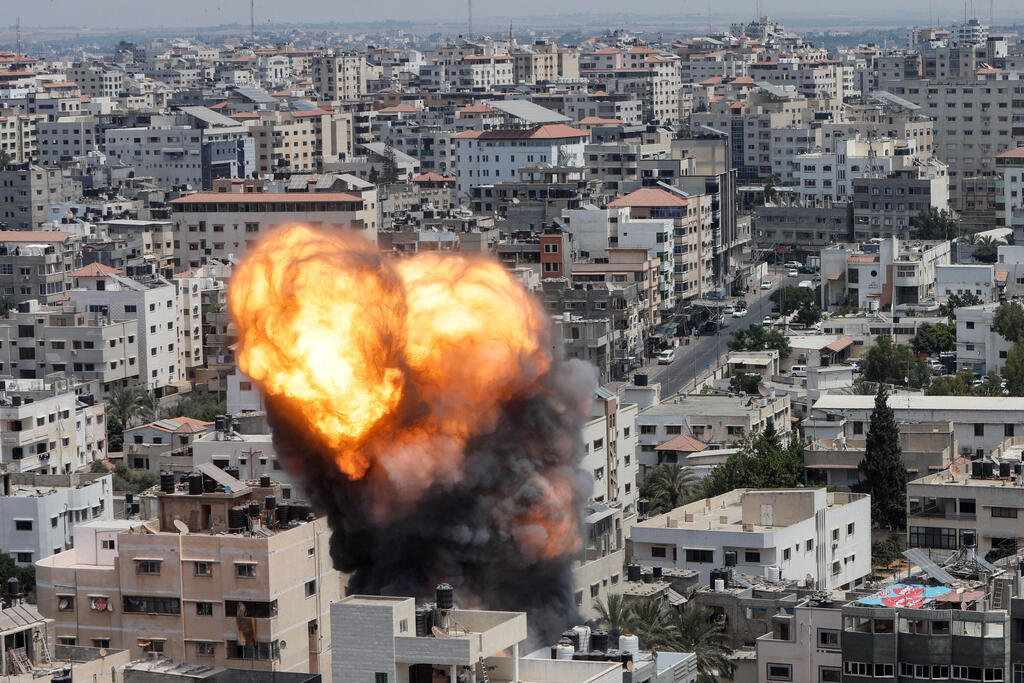
ISRAEL AT WAR
Hamas used Gaza economy as part of its deadly deception
The terror group publicly complained of financial problems, but proved that it has more than enough resources to invest in an attack on Israel. The price will be paid by the Palestinian people who live in the Gaza Strip, whose welfare is only secondary to the ideology of Hamas
Already two days into the war, its results are clearly visible on the ground in Gaza. According to UNWRA, as of this morning, there are already more than 120,000 displaced people in Gaza as a result of the Israeli Air Force's massive bombing of targets in the Gaza Strip. These displaced people have been taken in by the agency's schools in the Gaza Strip, while in Gaza there are estimates that the number will only increase significantly as the fighting progresses.
Currently, it is not yet known what the extent of the damage to the buildings and infrastructure was in Gaza in the first two days, but it is clear that this is only the beginning. According to UN estimates, in four previous rounds that took place between 2009 and 2021, the cumulative damage caused to the Strip is estimated at $5 billion. Even prior to the start of the current war, none of the damage from Operation Protective Edge in 2014 and the Operation Guardian of the Walls in 2021 had been repaired, and it seems that the damage in Gaza in this war will be far greater than what was seen in previous rounds of violence.
In the current war, according to statements, Israel is expected to change the equation and cause a fundamental change in the economic relations between Israel and the economy of the Strip, which is almost completely dependent on Israel. Israel should take into account that such a change will lead to the complete collapse of the Gazan economy. Israel controls the flow of electricity, fuel, goods and the movement of workers in the Strip and without all of these it will have difficulty functioning economically. Although there is an option to receive goods and fuel through Egypt, including smuggling, this does not answer the demand. In addition, the Egyptians don't have much motivation to provide the Hamas government with a lifeline of any kind.
Israel is Gaza's central electricity supplier
The Israeli pressure is clearly visible in the Gaza Strip already. The electric company in the Gaza Strip announced on Sunday at noon that the deficit in the supply of electricity to the residents reached 80% due to the interruption of the supply from the electricity lines in Israel. According to a source in the company, Israel cut off all power lines to the Gaza Strip. In addition, some of the central transformers that supply electricity to the various areas in the Gaza Strip were out of service as a result of the Israeli bombings.
It should be noted that the electricity sector in the Gaza Strip relies mainly on the Israeli lines, which supply more than 120 megawatts. To this must be added electricity produced at the local power plant, which has a production capacity of 65-120 megawatts, depending on the state of competence of its four generators. The operation of this station also depends on the supply of fuel from Israel, which is also expected to stop in the near future at least. Due to the distress, the company in Gaza announced that the electricity production capacity reached only about 60 megawatts, and therefore there was only enough electricity supply for four hours on Sunday.
Another important component of the Gazan economy is work in Israel. About 18,000 Gazan workers, which also include merchants, have work permits in Israel, which saw the granting of the permit to Gazans as an asset that Hamas would want to keep. The Gazans also fought for work permits in Israel, and Hamas encouraged the phenomenon as it allowed it to profit from the funds that came in from Israel and used them to establish its control over the Gazan economy as well as divert sums to its military arm. On average, the salary of a Gazan worker in Israel is around NIS 6,500 per month, a huge amount in Gaza Strip terms, six times the average salary of a local laborer. In a rough calculation, this is an income of about $3 million a day for the Gaza Strip from employment in Israel - a significant amount for the local economy.
However, it is important to emphasize that the employment of Palestinians in the Israeli market has not been able to solve the chronic problem of unemployment in the Strip, which hovers around a rate of 50%. Although this is a high unemployment rate, it is low compared to the corresponding period at the end of 2020, when the unemployment rate skyrocketed to about 80%.
But it seems that all these hardships of the residents of Gaza were not at the forefront of Hamas's mind, which has been busy in the past two years since the end of Operation Guardian of the Walls in building up its military capabilities and preparing a meticulous battle plan, which it implemented with deadly success on Saturday. In the end, for the leaders of Hamas, the ideological consideration prevailed over the economic consideration, while misleading Israel and the multitude of intermediaries. Hamas managed to convince Israel, as well as factors in the Arab world, that it is ready for a limited period of calm in exchange for economic assets and the restoration of the Strip. In practice it seems that this was part of the fraud plan that the military branch used as part of the surprise it prepared for Israel.
The funds of Qatar, the main financier of Hamas in recent years, have become part of Hamas' plan to create in the region, including in Israel, the feeling that everything is connected to the flow of cash. During the month of August, the Hamas government in Gaza declared its inability to pay salaries to its employees. Hamas claimed that in recent months the cash has not arrived in Gaza every month, and the amounts have also dropped significantly from $10 million a month to only $3 million.
The reason for the cooling of relations between Qatar and Hamas stemmed from the terrorist organization's approach to the regime of Syrian President Bashar Assad. The Qataris, who remain the only country in the Arab world opposed to normalization with the Assad regime, were not enthusiastic about the connection between Hamas and Syria. In addition, Hamas claims that Qatar demands in exchange for a full transfer of the funds that Hamas commits to a calm, at least during the Jewish holidays.
Looking back, it turns out that Hamas had funds available to upgrade the capabilities of the military arm, while the plight of the civilians was only marginal in its considerations.














